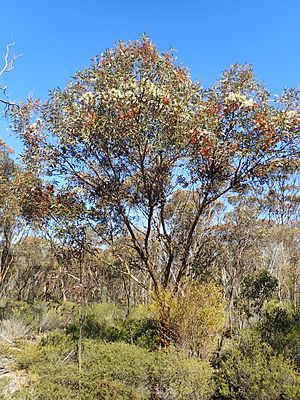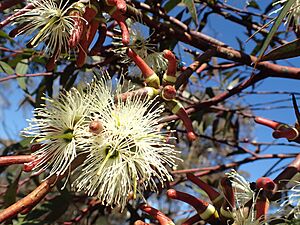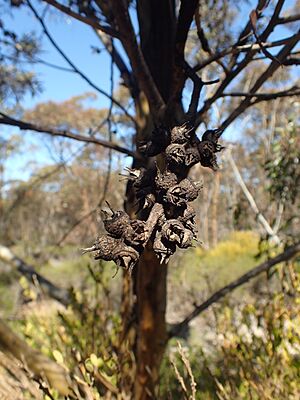Eucalyptus extensa facts for kids
Quick facts for kids Eucalyptus extensa |
|
|---|---|
 |
|
| Eucalyptus extensa flowers near Ravensthorpe | |
| Scientific classification | |
| Genus: |
Eucalyptus
|
| Species: |
extensa
|
Eucalyptus extensa is a special type of eucalypt tree. It's often called a "mallet" because of how it grows. This tree is found only in Western Australia, which means it's endemic there. It has smooth bark and long, thin adult leaves shaped like a spear. Its flowers are yellowish-green and grow in groups of seven. After flowering, it produces round, woody fruits.
Contents
What Does Eucalyptus extensa Look Like?
Eucalyptus extensa is a type of mallet tree. It usually grows to be about 3 to 8 meters (10 to 26 feet) tall. This tree does not have a lignotuber, which is a woody lump at the base that helps some eucalypts regrow after a fire.
Its bark is smooth and can be powdery. It comes in shades of grey, grey-brown, green, or yellow. The adult leaves are glossy dark green on both sides. They are narrow to broadly spear-shaped. These leaves are typically 10 to 105 millimeters (0.4 to 4.1 inches) long. They are also 7 to 18 millimeters (0.3 to 0.7 inches) wide. Each leaf has a stem, called a petiole, that is 6 to 17 millimeters (0.2 to 0.7 inches) long.
Flowers and Fruit
The flower buds grow in groups of seven. They are found where the leaves meet the stem, called the leaf axil. These buds sit on a flat stem, or peduncle, that is 5 to 15 millimeters (0.2 to 0.6 inches) long. Each individual bud has a small stalk, or pedicel, 2 to 6 millimeters (0.08 to 0.24 inches) long.
When mature, the buds are quite long, 24 to 32 millimeters (0.9 to 1.3 inches). They are also 5 to 7 millimeters (0.2 to 0.3 inches) wide. The top part of the bud, called the operculum, is long and pointy. It can be up to five times longer than the base of the flower.
Eucalyptus extensa has yellowish-green flowers. They have been seen blooming in March and October. After the flowers, the tree produces woody fruits. These fruits are shaped like half a sphere. They are 6 to 8 millimeters (0.2 to 0.3 inches) long and 8 to 12 millimeters (0.3 to 0.5 inches) wide. The fruit has a narrow disc and three or four valves. These valves stick out far beyond the edge of the fruit. The seeds inside are brown to straw-colored. They are usually cuboid or egg-shaped and 1.8 to 3 millimeters (0.07 to 0.12 inches) long.
How Was Eucalyptus extensa Named?
The scientific name Eucalyptus extensa was first officially described in 1991. Two botanists, Lawrence Alexander Sidney Johnson and Ken Hill, gave it this name. They published their description in a science journal called Telopea. The first specimen they studied was found near the road between Hyden and Norseman.
The second part of the name, extensa, comes from the Latin word extensus. This word means "stretched out" or "extended." This refers to the long, stretched-out opercula (the cap) on the flower buds.
Where Does Eucalyptus extensa Grow?
This mallet tree grows in the southern parts of Western Australia. You can find it in sandy plains and gently rolling areas. These areas are part of the southern Wheatbelt and the southwestern Goldfields-Esperance regions. It prefers to grow in red loam, grey sandy loam, and sometimes gravelly soils.
Is Eucalyptus extensa Endangered?
The Western Australian Government's Department of Parks and Wildlife has looked at the status of this eucalypt. They have classified Eucalyptus extensa as "not threatened." This means it is not currently at risk of disappearing.




